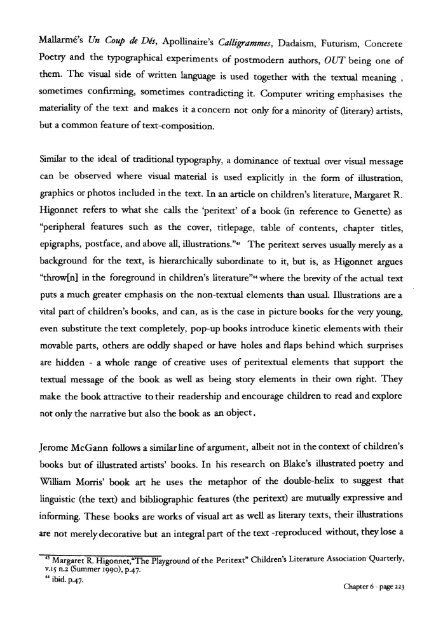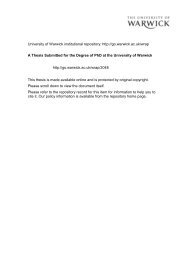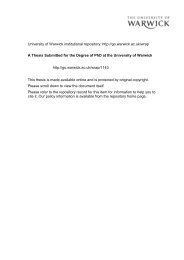From Page to Screen - WRAP: Warwick Research Archive Portal ...
From Page to Screen - WRAP: Warwick Research Archive Portal ...
From Page to Screen - WRAP: Warwick Research Archive Portal ...
You also want an ePaper? Increase the reach of your titles
YUMPU automatically turns print PDFs into web optimized ePapers that Google loves.
Mallarme's Un Coup de Dis, Apollinaire's Calligrammes, Dadaism, Futurism, Concrete<br />
Poetry and the typographical experiments of postmodem authors, OUT being one of<br />
them. The visual side of written language is used <strong>to</strong>gether with the textual meaning ,<br />
sometimes confirming, sometimes contradicting it. Computer writing emphasises the<br />
materiality of the text and makes it a concern not only for a minority of (literary) artists,<br />
but a common feature oftext-composition.<br />
Similar <strong>to</strong> the ideal of traditional typography, a dominance of textual over visual message<br />
can be observed where visual material is used explicitly in the form of illustration,<br />
graphics or pho<strong>to</strong>s included in the text. In an article on children's literature, Margaret R.<br />
Higonnet refers <strong>to</strong> what she calls the 'peritext' of a book (in reference <strong>to</strong> Genette) as<br />
"peripheral features such as the cover, titlepage, table of contents, chapter titles,<br />
epigraphs, postface, and above all, illustrations.?» The peritext serves usually merely as a<br />
background for the text, is hierarchically subordinate <strong>to</strong> it, but is, as Higonnet argues<br />
"throw{n] in the foreground in children's Iiterature'vwhere the brevity of the actual text<br />
puts a much greater emphasis on the non-textual elements than usual. Illustrations are a<br />
vital part of children's books, and can, as is the case in picture books for the very young,<br />
even substitute the text completely, pop-up books introduce kinetic elements with their<br />
movable parts, others are oddly shaped or have holes and flaps behind which surprises<br />
are hidden - a whole range of creative uses of peritextual elements that support the<br />
textual message of the book as well as being s<strong>to</strong>ry elements in their own right. They<br />
make the book attractive <strong>to</strong> their readership and encourage children <strong>to</strong> read and explore<br />
not only the narrative but also the book as an object.<br />
Jerome McGann follows a similarline ofargument, albeit not in the context of children's<br />
books but of illustrated artists' books. In his research on Blake's illustrated poetry and<br />
William Morris' book art he uses the metaphor of the double-helix <strong>to</strong> suggest that<br />
linguistic (the text) and bibliographic features (the peritext) are mutually expressive and<br />
informing. These books are works ofvisual art as well as literary texts, their illustrations<br />
are not merelydecorative but an integralpart ofthe text -reproduced without, they lose a<br />
43 Margaret R. Higonnet,"The Playground ofthe Peritext" Children's Literature Association Quarterly,<br />
V,I5 n.z (Summer 1990), P.47.<br />
44<br />
Iibid I . P.47.<br />
Chapter 6 - page 223





